Aleutia Relia Industrial PC Review: Ivy Bridge & Q77 in a Fanless Chassis
by Ganesh T S on December 4, 2012 10:00 AM EST- Posted in
- Industrial PC
- HTPC
- Ivy Bridge
- Aleutia
Performance Metrics:
In our HTPC reviews, we devote a section to general performance metrics and multiple sections to various HTPC aspects. The Aleutia Relia review unit's Core i7-3770T has the HD4000 GPU inside, and its HTPC performance with respect to rendering and decoding is well known. For this review, we will have a section devoted to performance metrics at room temperature (72 F) and just one additional section for the HTPC aspects (given the target market for the system).
Windows Experience Index and SSD Performance
This metric is often considered meaningless, but we feel it serves as an indicator of what could be the bottleneck in the system. Surprisingly, it was not the HD4000 GPU, but the primary hard disk (Crucial 128 GB mSATA SSD) which initially gave a score of 5.9 to the system.

The Crucial mSATA SSD is supposed to deliver much better performance (since it is based on a comparatively higher end Marvell controller, unlike the cheaper mSATA SSDs based on Phison). To make sure that the SSD was performing to its full potential, we created a partition on the SSD and ran our 4-corner IOMeter benchmark.
| IOMeter Performance | |
| Test | Transfer Rate (MBps) |
| 4 KB Random Write | 125.90 |
| 4 KB Random Read | 60.49 |
| 128 KB Sequential Read | 218.68 |
| 128 KB Sequential Write | 154.18 |
These figures are certainly not bad enough to give a score of 5.9 in the Windows Experience Index. A quick check revealed that the Intel Rapid Storage Technology driver hadn't been installed in the first run. After installation, the score for the primary drive moved on to 7.8, and the system score, as expected, was pulled down by the HD4000 GPU to 6.6.

Futuremark Benchmarks
We pit the Aleutia Relia against other low power industrial / enterprise PCs that have been reviewed on our site earlier.
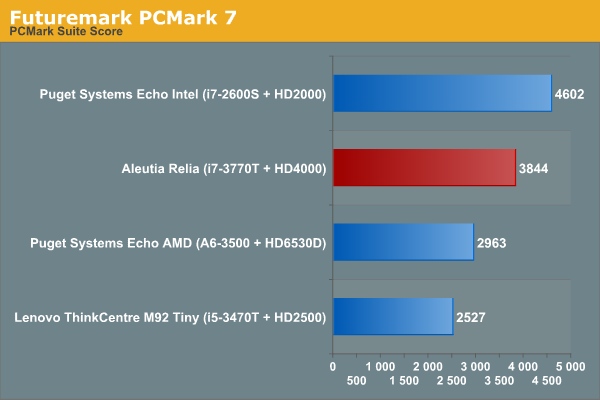
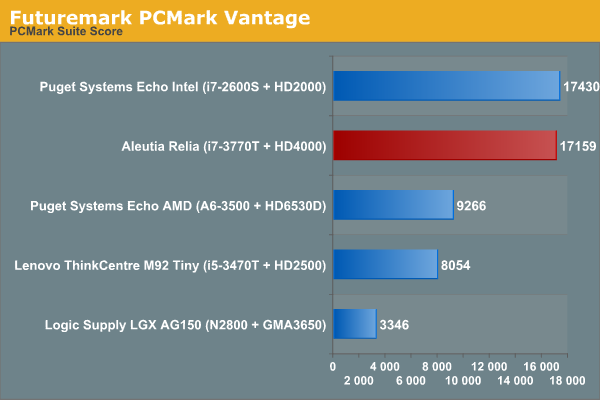
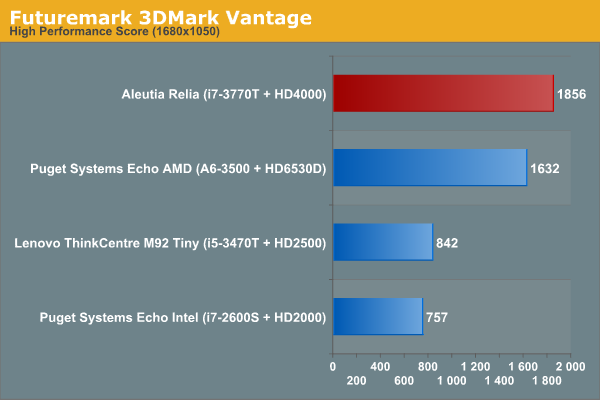

The Aleutia Relia performs consistently well, thanks to its SSD and upgraded HD4000 GPU. It loses out to the i7-2600S based Puget Systems Echo in some benchmarks, but that is because the i7-3770T is a 45W TDP CPU running at 2.5 GHz in comparison to the i7-2600S which is a 65W TDP CPU running at 2.8 GHz.
Miscellaneous Benchmarks
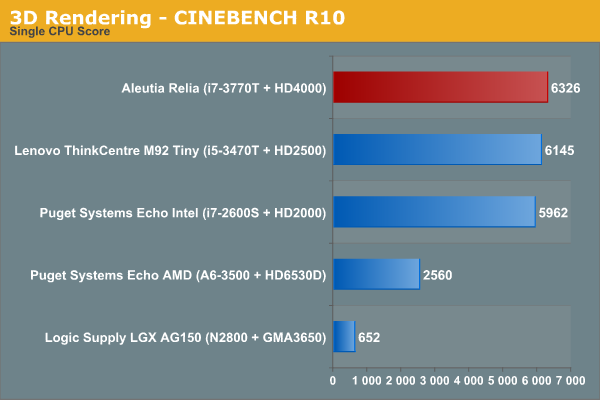
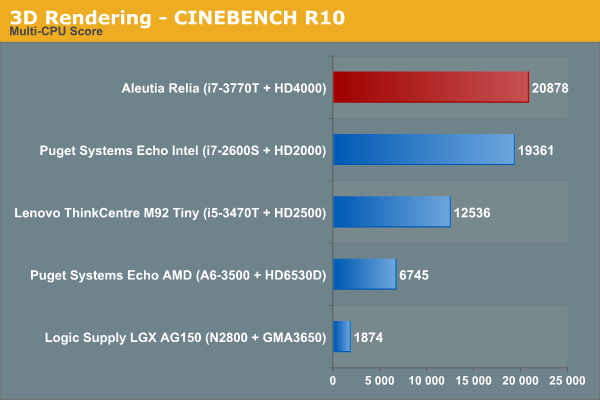
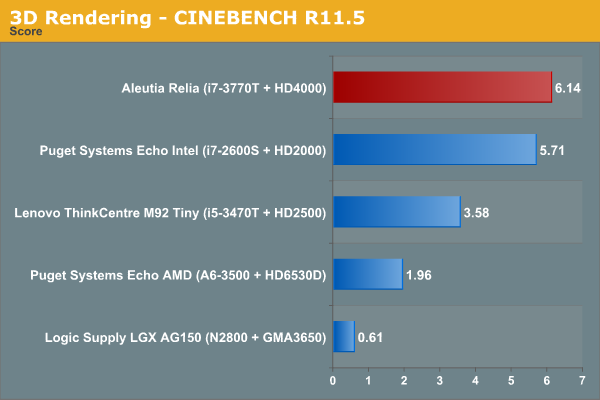
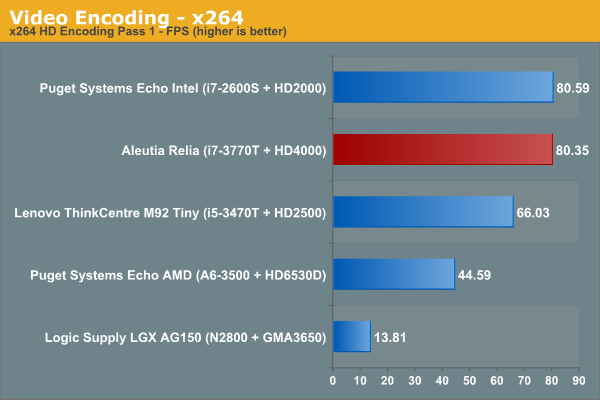
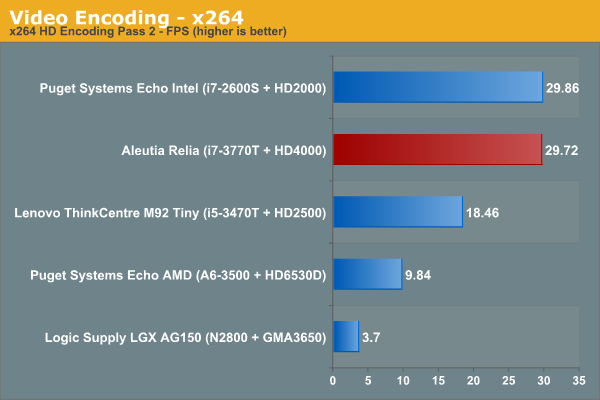
Ivy Bridge brings us strong single-threaded performance and the Aleutia Relia is impressive enough. As more cores are brought into the picture and the CPU loads up, throttling sets in and causes a drop in performance (not quite visible in the above benchmarks, but quite obvious when the FPS figures for each x264 run are observed - ranging from 86 fps in the first run to less than 70 fps in the fourth). That said, the i7-3770T should be adequate for most industrial PC tasks.
An estimate of how well WinRAR performs, particularly with respect to processing split archives, wraps up this section. To evaluate this, we take a 4.36 GB MKV file, compress it in the 'Best' compression mode into a split archive (97.1 MB each), which results in 44 files on the hard disk. The time taken to decompress this split archive is then recorded. The performance in this benchmark is heavily influenced by the disk in the system. For comparison, we use our HTPC review systems. In order to get an idea of how the disk influences the results, we repeated the run with the source and destination being the SSD as well as the HDD.
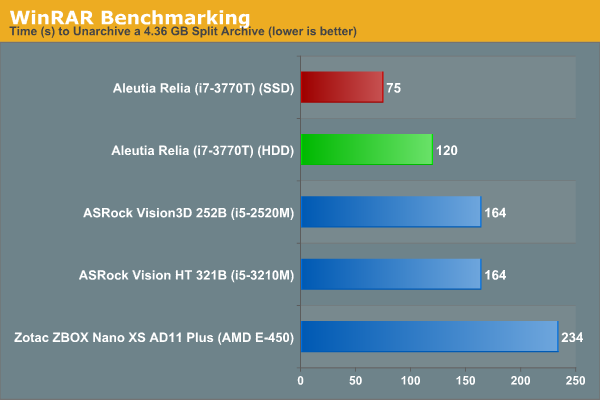










47 Comments
View All Comments
Rick83 - Tuesday, December 4, 2012 - link
I see you mention the NIC on the last page (might have been better placed on the first page, where you list the components), so the hardware is there.Is BIOS support there as well?
Haven't seen anything from the BIOS so far, and AMT is heavily dependant on entire-system support.
Did you actually get a KVMoIP session to work?
While this particular model is not that interesting to me, I am looking generally into systems with AMT support, so getting to know the functionality that each vendor provides is quite interesting.
jhh - Tuesday, December 4, 2012 - link
I suspect a slower RAM was selected to work in a fanless device, but if you had an IR camera, it would have been nice to confirm device temperatures. The case top probably adds to the case heat-sink capacity, so removing the top could cause problems with the processor and its heat-pipe to the case, which would make it difficult to take such a picture.Minion4Hire - Wednesday, December 5, 2012 - link
That doesn't seem likely. There's not much in the way of chassis ventilation and the heatpipes connect directly to those side heatsinks. If anything temperatures should drop with the cover removed as less heat can be trapped inside of the chassis, although in a temperature controlled testing environment with zero airflow it might not really matter.Googer - Monday, December 17, 2012 - link
Cooling isn't necessary DDR3 1600 as most ram chips generate very little heat. Modern day DIMM salesmen add heatspreaders and heatsinks, mostly as a marketing ploy.cjs150 - Tuesday, December 4, 2012 - link
I have recently built a very similarly spec HTPC (using the HDplex case rather than what I guess is a streamcom/wesean case) so it was nice to see a comparison. Price is a lot more reasonable than my build.i7-3770T works extremely well as an HTPC (shame about screen refresh rate - Intel should hang their heads in shame)
Personally I would not use a mechanical hard disc, I hate noise and for an HTPC, an SSD is fine.
The problem as I see it for an HTPC is that if no optical drive or TV tuner why bother with something this complex, probably easier and cheaper to store all the media on a NAS and have a very cheap streaming device as the HTPC.
After saying that, none of the fanless cases I have looked at that support an optical drive give any thought to noise dampening the drive.
Kevin G - Tuesday, December 4, 2012 - link
Looking at the internal layout, I can easily see why the hard drives get hot: one is mounted directly over the CPU. I wonder how just a single hard drive mounted over the memory performs with regards to temperatures and throttling.It also looks like the Wi-fi chip is replaceable so that single band disadvantage can be rectified.
My only other complaint would be the 19V external power supply. It would have been nicer to see a 12V external PSU or even an internal PSU to avoid a power brick entirely. Minor quibble in the grand scheme of things.
Guspaz - Tuesday, December 4, 2012 - link
The as-configured price seems to be at least $500 overpriced. This thing has a BOM somewhere around $900ish at *RETAIL* pricing (I made a list), $1500 for the machine is ridiculous.mrdude - Tuesday, December 4, 2012 - link
Poor WiFi that only offers single-bandNo card reader
No Bluetooth
Aaaaand somehow this is supposed to be an HTPC? viable small form factor PC? At that price? say what?
These people must be kidding themselves.
A5 - Tuesday, December 4, 2012 - link
No, this is designed to be used in an industrial environment. I have no idea why Ganesh tested it as an HTPC.Aikouka - Tuesday, December 4, 2012 - link
I would assume that it's being tested as a HTPC device because it looks like a decent contender on paper.Also, keep in mind that you can just buy your own Streacom case and build your own machine. They have models with card readers, disc drive access, etc.